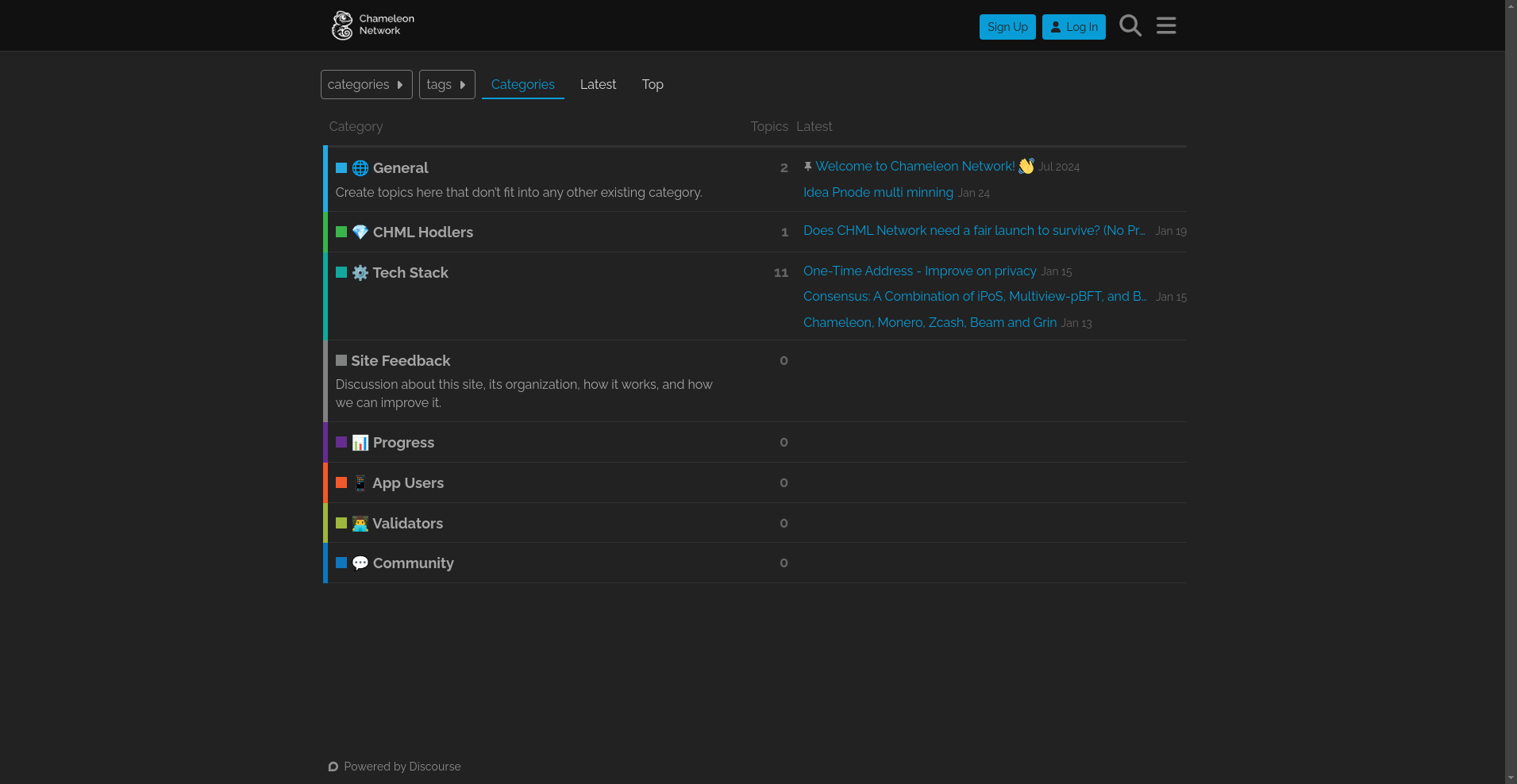Chameleon Network ($CHML) Review: A Data-Driven Legitimacy and Risk Assessment

What Is Chameleon Network: An Introduction
Chameleon Network is an emerging blockchain project positioned as a privacy-centric platform within the decentralized ecosystem. Built on the Ethereum network, it aims to redefine digital privacy by offering secure, confidential transactions without compromising usability or regulatory compliance. The project emphasizes the integration of advanced cryptographic techniques such as zero-knowledge proofs and ring signatures, targeting a future where privacy is accessible to mainstream users.
This review provides an impartial analysis of Chameleon Network's core technology, team credibility, security posture, economic model, and development activity, aiming to help potential investors and users evaluate its legitimacy and associated risks.

The Team and Roadmap Evaluation
Examining publicly available information, the team behind Chameleon Network appears to consist of blockchain developers and privacy technology specialists. While detailed backgrounds of individual members are not explicitly disclosed, their active engagement through social media, community forums, and transparent documentation suggests a concerted effort to build trust and credibility. The presence of security audits and open-source repositories further supports their intent to maintain transparency.
Roadmap highlights include:
- Q1 2025: Launch of testnet and core app, initial token presale, DAO creation, and uniswap listing.
- Q2 2025: Mainnet deployment, security audits, expansion of staking infrastructure, and app rollout.
- Q3 2025: Ecosystem growth, new security modules, cross-chain interoperability, and strategic partnerships.
- Q4 2025 and beyond: Community governance, token utility expansion, hardware partnerships, and continued scaling efforts.
The detailed timeline demonstrates an organized development plan, suggesting a focused approach to building and expanding the project. However, the execution risk remains contingent on their ability to meet these deadlines and deliver functional, secure solutions, highlighting the importance of evaluating crypto project roadmap risk factors.

Assessing the Security and Integrity of Chameleon Network
Analysis Based on Cyberscope Audit Report: The audit, conducted on January 19-23, 2025, provides a foundational view of the network's security posture. The audit assessed the project's smart contract code, which is a critical component for trustworthiness.
Key findings include:
- Security Score: 90/100, indicating a high level of security maturity.
- Critical Vulnerabilities: One high-criticality issue identified, which requires further resolution and monitoring.
- Decentralization Score: 35/100, suggesting potential centralization concerns in node distribution.
- Community Score: 73/100, reflecting reasonably positive community engagement.
- Audit Scope: Focused on token contracts with some unspecified vulnerabilities.
The presence of a critical vulnerability underscores the importance of ongoing security audits and continual code improvements before mainnet deployment. While the audit indicates a generally positive security stance, the identified issues pose risks that users and investors should monitor carefully. This emphasizes the value of understanding high-criticality vulnerabilities' impact.
It is essential to recognize that security audits are just one layer; comprehensive security depends on further testing, code revisions, and the robustness of operational security practices.
A Breakdown of Chameleon Network Tokenomics
The economic structure surrounding the CHML token reveals a fixed total supply designed for scarcity and long-term value preservation. The tokenomics are structured to incentivize community participation, network security, and ecosystem growth. Understanding tokenomics best practices for crypto projects is crucial here.
- Total Supply: 100 million CHML, with no additional minting planned.
- Distribution Breakdown:
- Community Airdrop: 5% (5 million CHML), subdivided into 4% for early supporters and 1% for beta testers.
- Presale: 20% (20 million CHML) at $0.45 in Round 1, with phased unlocking.
- Reward Pool: 65% (65 million CHML) for validators (70%) and liquidity providers (30%).
- Initial Liquidity Pool: 2% (2 million CHML) for supporting trading pairs.
- Staking Infrastructure: 5% (5 million CHML) to support node operations.
- Ecosystem Development: 3% (3 million CHML) for community and developer incentives.
The valuation and utility of CHML revolve around transaction fees, staking, and governance participation. The fixed cap potentially creates supply scarcity; however, success hinges on widespread adoption and the actual demand for private transactions within the ecosystem. The allocation for reward pools aligns with incentivizing decentralization, but the proportional emphasis on validator and liquidity rewards warrants scrutiny concerning centralization risks and token dumping pressures.
Assessing Chameleon Network's Development and Ecosystem Activity
Current development activity, as deduced from available resources and community outreach, indicates the project is in pre-alpha with active engagement in community quests, a forthcoming pre-sale, and plans for mainnet launch. The presence of detailed technical documentation such as whitepapers, roadmaps, and pitch decks signifies a committed effort to transparency and investor confidence.
Notably, the project emphasizes a hybrid node infrastructure, including physical pNodes (hardware devices) designed to increase decentralization, and vNodes (virtual nodes) for flexibility and scalability. The active community on Telegram (over 12,000 members) and presence on Discord, Twitter, and GitHub suggest a strategically built outreach plan. The emphasis on physical nodes is a key factor in their decentralization strategy.
While concrete milestones like mainnet deployment and cross-chain privacy features are scheduled, the actual implementation risk remains, considering the technological complexity of privacy-preserving protocols.
Reviewing the Terms and Conditions
The project's publicly available Terms of Service and Privacy Policy provide standard operational frameworks. They specify user responsibilities, such as lawful use and data accuracy, and outline security measures involving Cloudflare and CrowdSec for threat mitigation. No overtly unusual or risky clauses were identified.
Key points include:
- Clear disclosures about data collection, security measures, and third-party integrations.
- Right to modify terms with immediate effect upon publication.
- User rights for data correction and withdrawal of consent.
Overall, the legal framework appears standard for crypto projects, with no immediate red flags regarding investor protections or privacy breaches.
Final Analysis: The Investment Case for Chameleon Network
Chameleon Network presents itself as a promising, privacy-focused blockchain aiming for broad applicability across DeFi and cross-chain interactions. The project has a comprehensive roadmap, reputable documentation, and active community engagement. Its security audit, despite revealing a critical vulnerability, indicates a proactive approach to security.
However, inherent risks include technological complexity, potential centralization in node setup, and market competition from established privacy coins like Monero and Zcash. The fixed token supply, while appealing for scarcity, depends heavily on successful adoption and regulatory environments that may challenge privacy protocols.
Potential investors should weigh the ambitious technological goals and community-driven development against the risks of implementation delays, security vulnerabilities, and regulatory headwinds. Due diligence—particularly ongoing security assessments and real-world network performance—is essential before committing significant capital. It's vital to understand the community score and other metrics for evaluation.
-
Pros / Strengths
- Innovative hybrid consensus with security focus
- Active development plan with clear milestones
- Strong community engagement and transparency
- Advanced cryptographic privacy techniques
- Fixed token supply supporting scarcity
-
Cons / Risks
- Security vulnerabilities identified in audit
- Potential centralization in node operation
- Technological complexity may delay deployment
- Market competition from established privacy coins
- Regulatory challenges around privacy features
In conclusion, Chameleon Network exhibits strong technical ambition and community backing, with notable steps toward decentralization and security. Nevertheless, as with any nascent crypto project, it carries significant risks that must be considered within the context of your individual risk appetite and due diligence requirements. This assessment aims to offer a balanced perspective, empowering investors and users to make informed decisions based on available evidence.

Jessica Taylor
NFT Market Data Scientist
Data scientist specializing in the NFT market. I analyze on-chain data to detect wash trading, bot activity, and other manipulations that are invisible to the naked eye.
Similar Projects
-
Catwifmask ($MASK)
Crypto Project Scam Checker: In-Depth Review and Safety Analysis of Catwifmask ($MASK) - Is It a Scam or Legit?
-
Poscidon
In-Depth Review of Poscidon: Crypto Project Scam Checker & Risk Analysis
-
Lyra Finance
Lyra Finance ($LYRA) Review: A Data-Driven Analysis of Risks & Strengths
-
MetaBudz
MetaBudz Review: Crypto Project Scam Checker and Risk Analysis
-
Bark
Bark ($BARK) Review: Risks, Security & Project Analysis